Outer Corsets and Inner Corsets
I have often written about the elegance of people in bygone years. The women, sometimes corseted, show striking deportment.
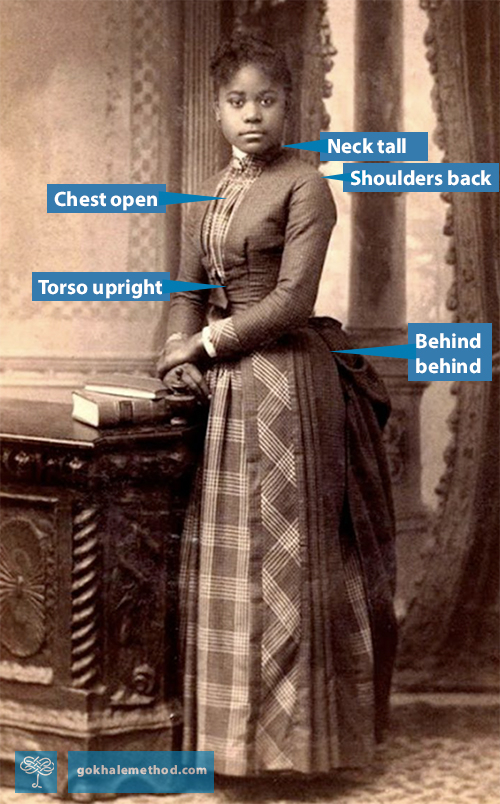
This young woman shows wonderful alignment and poise in an age when corsets were commonly worn. Corsets encouraged abdominal support, a tall straight spine, and the behind behind. Pinterest
The excesses of nineteenth-century fashion understandably gave corsets a bad name. Extreme tight lacing had some terrible effects, imposing some drastic anatomical remodeling:
The stomach and liver are crammed down, with the ribs compressing into drooping S-loops. The neural spines of each vertebra, the little projections that stick up from the central body of each bone, are also pushed out of place. Normally they stack nicely one atop the other in a neat midline ridge, but in long-term corset wearers these spindles of bone jut to this side or that.
Science writer Brian Switek in Skeleton Keys: The Secret Life of Bone.

The extremes of nineteenth century corsetry had unhealthy effects, including restricting breathing and digestion (left). Wikimedia
The majority of people nowadays enjoy the freedom of not wearing a corset, and are understandably determined never to return there. However, some kinds of external corset, well chosen and used judiciously, can have protective benefits for the lower back area. They can also serve as a training tool for developing a stronger, healthier, inner corset. Let’s consider this in more detail.
External corsets can offer protection in some contexts
Belts and corsets are often worn by manual workers—for lifting heavy goods at Home Depot, for example. The extra stability they give the trunk can be protective in awkward maneuvers, when workers are tired, if they have previous injuries, or are vulnerable due to a weak “inner corset.”
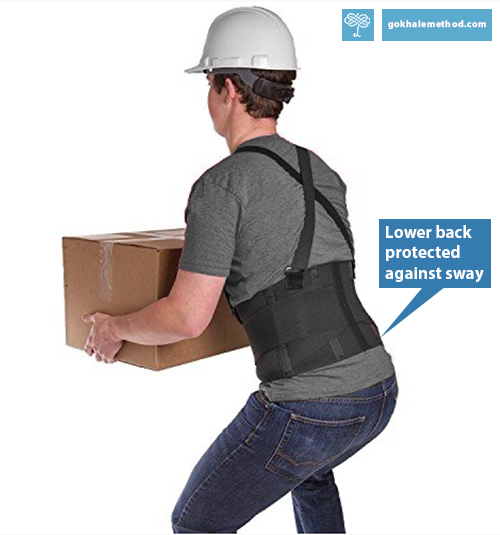
A corset provides extra protection for the lumbar spine, which, unlike the thoracic spine, is not protected by the architecture of the ribcage. Ninelife.uk
Another common use for external corsets is in weight lifting. In this case, should the natural inner corset fail and the considerable weight over challenge the lifter, a resultant twist or buckle of the spine could cause serious injury. The corset will guard against this and also help the lifter to maintain length and space in the lumbar area despite the compressive force from the weights.

A weightlifter protects his lower back with a belt. Unsplash
External corsets can be useful training aids
A corset or belt can give a feeling of strength and stability that you want your own muscles to provide. A corset or belt can be used as a reminder and a training tool. External corsets can be used as supplements to your own inner corset musculature, not instead of it, when bending, lifting and carrying.
Healthy posture trains your inner corset
Healthy posture naturally strengthens your inner corset. Poor posture will lead you to slump and collapse your inner corset, or sway and make your back muscles overwork and tighten. Either way, your inner corset is sidelined, making you more vulnerable to injury and degenerative spinal conditions.
Some traditional cultures wear external corsets
Some societies have integrated corsets into their traditional dress. Members of the Dinka tribe from Southern Sudan, Africa, wear surprisingly rigid corsets with metal ribbing and beading to show their status. These are worn day and night for years. The corsets allow no appreciable flexion, extension, side-bending, or twisting, yet the excellent physique of the young men and women who wear them is testimony to how little spinal movement may be necessary to preserve good health.
A member of the Dinka tribe wearing a corset. Note that the L5-S1 area is allowed to assume its normal curvature.
Another corset-like garment, this time from East Asia, is the Japanese obi, or sash, worn in various styles with different types of kimonos. Nowadays they are mainly reserved for bridal wear. Over the centuries, owing to their increasing ornamental width and stiffness, other more functional belts would be tied underneath to close the kimono.

A woman tying the obi of a geisha in the 1890s. Wikimedia
Gokhale Method students can make use of corsets
Some of our students have explored wearing corsets. Alumna Fatimah has experimented with very different types of corsets. She tells us that in the old days in Java the kemben, an item of traditional clothing she knows from her Indonesian heritage, was similar in function to the modern bustier, and was worn with a sarong (wrap around skirt). However, nowadays most people would wear a sarong with a corset over it, and a kebaya (longer blouse/jacket, sheer and often lacy) on top. Fatimah remembers her grandmother wrapping herself in a sash that acted as a corset over her sarong, with a long straight kebaya on top.
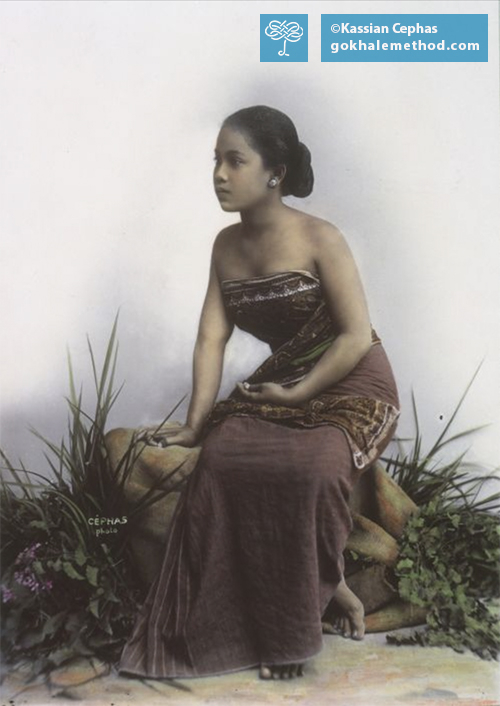
A woman wearing a kemben, the traditional Indonesian female torso wrap, circa 1900.
The traditional kemben is worn by wrapping a piece of cloth around the torso, folding and securing the edge, tying it with binding, and then covering it with a sash or angkin around the abdomen. Today, there are also tight-fitting and tailored kemben secured using buttons, straps, or zippers similar to the Western corset. Wikimedia
Modern shapewear as a corset
Modern shapewear is, as the name suggests, usually worn to achieve a smooth and shapely body contour—in the case of the corset, while reducing the waist. The sensation of wearing it can provide a reminder to engage the deep abdominal muscles. Fatimah discovered a shapewear corset via her hairdresser, who uses it while working to prevent back pain. Fatimah comments:
If I wear it high, covering my lower ribs, it reminds me to engage my rib anchor, keeping my front ribs down and flush with my torso and avoiding swaying my back. I actually don’t find it comfortable to wear for long periods, so I’m getting good at remembering to use my rib anchor without it!
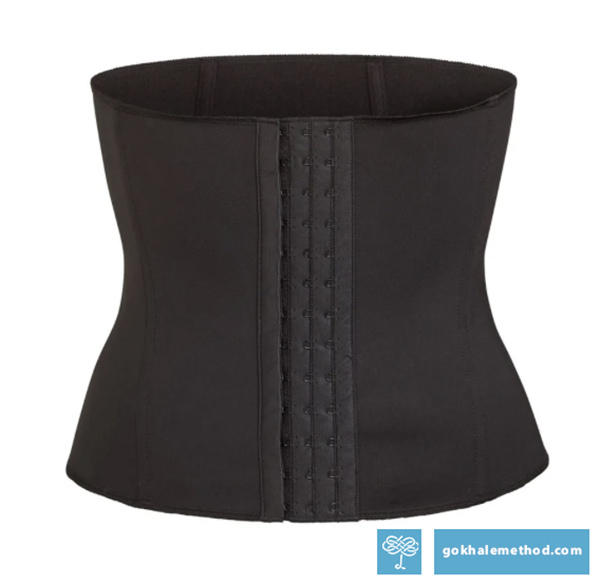
A SKIMS corset, a modern piece of shapewear in a style made popular by Kim Kardashian. Pinterest
Ideally, we all have a strong, natural inner corset
Since our first human ancestors stood upright some 5–7 million years ago, we have acquired not only a J-spine but also a strong matrix of tissues designed to support and protect it. (You can read more about spine shape here.) We evolved perfectly to do this. Unfortunately, about one hundred years ago, our industrialized culture took a wrong turn in notions about healthy posture. Going forward into modern times, we have exported a distorted view of human posture to much of the world through our design, fashion, and manufacturing. This unraveling of global postural health and traditions is explained in more detail in my book, 8 Steps to a Pain-Free Back.
Fortunately, there remain traditional societies where healthy, pain-free posture is still intact, and they provide precious role models for us to learn from. The Gokhale Method® in-person Foundations and Pop-up courses, and our online Elements course, teaches how to stand, bend, walk, and even sit as these people do. The inner corset is also explained in detail in my book 8 Steps to a Pain-Free Back.
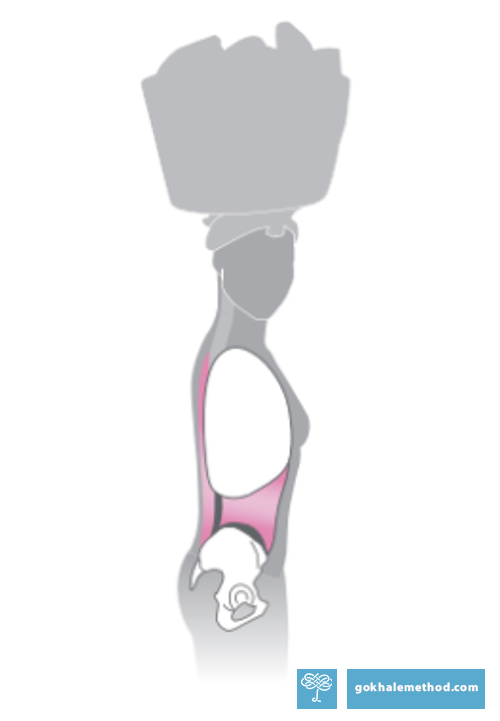
The muscles of the inner corset include the deep intrinsic back muscles, the abdominis transversus, and the obliques.
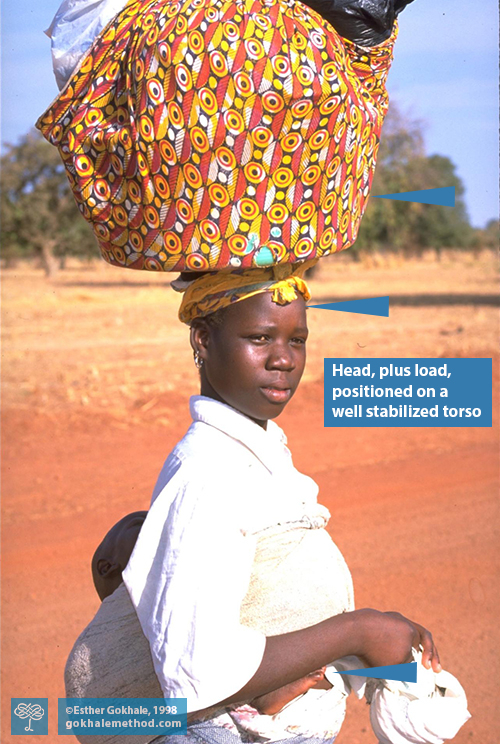
This young mother in Burkina Faso is using her inner corset to remain tall, stable, and relaxed while carrying on her head with her baby on her back. Headloading, done well, can encourage the inner corset to engage and the spine to align. Traditional posture principles really work!
Strengthening your inner corset
There are few of us who can’t do without some attention to our inner corset. What you don’t want to do is common ab exercises such as the aptly named crunches, which squish your discs and crunch your spine, or, worse, sit-ups. You can read more about ab exercises here.
We recommend you start by learning to use your rib anchor, an ingredient of your inner corset, which will prevent you from swaying and compressing your lumbar area. You can watch our free rib anchor video here.
If you would like guidance on any aspect of your posture, including ways to cultivate your inner corset and protect your back, consider scheduling an Initial Consultation, online or in person, with a Gokhale Method teacher.

Comments
The link to more info about
The link to more info about ab exercises doesn't seem to work
Hi Anne,Thank you for
Hi Anne,
Thank you for reporting this. We have fixed the issue on the link. Kindly check again.
Have a great day!
Best,
Kresyl - Customer Support
I love wearing a boned corset
I love wearing a boned corset. I wish more focus was paid to normal corset wearing and not the extremes like tight-lacing. Tight lacing was, and still is, not common. Even fainting was a literary device that women copied to accomplish a purpose and get attention. There is ample evidence showing that the modern-day opinions about corsets are based upon assumptions and sensationalized misinformation. It's fun and it gets clicks, but it is far from the truth about normal corset wearing.
While I was first rehabilitating my back I wore a boned corset for about a year, even "stealthing" at work as a massage therapist. At work I wore a shorter corset termed a "waspie". It was properly fitted and broken in to form to my natural body. I found the fact that it provided support with the bones and also formed itself to my body made it better then any other modern "brace" I have ever used. It wasn't just a tight, compressing tube, it was structured and ME-shaped! It was insanely comfortable and gave me the support when I needed it and also kept me from falling into a bad posture habit I had developed while sitting that was re-injuring my lumbar spine. In conjunction with the Gokhale Method this was amazingly effective. The corset even encouraged a more open chest and helped my neck by making proper posture easy. I didn't want to rely on my corset but it was there when I needed it either as a reminder or support when I became too fatigued. I rarely wear mine now, as the Gokhale Method has helped me develop my innner corset but sometimes when I am tired or already in pain and want to slump, I'll put it on. It's available and effective when I need it, as any good tool should be.
Add New Comment
Login to add commment
Login